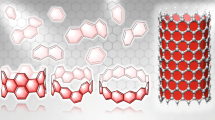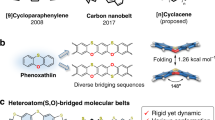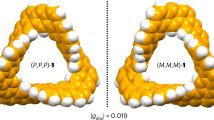Abstract
Twisted aromatic belt molecules provide unique topologies and complex chiralities for nanocarbon materials. However, a synthetic method for aromatic belts with multiple twists remains elusive. Here we report the catalytic and stereoselective synthesis of doubly, triply and quadruply twisted aromatic belts (up to e.r. = 98:2) via rhodium(I)-catalysed asymmetric [2 + 2 + 2] cycloadditions. The hybrid substrate design, consisting of curved metaphenylene units and linear paraphenylene units, overcomes the hurdles of conventional methods, that is, large twist strain and unravelling of twists during belt formation, allowing the coexistence of multiple P- and M-twists in a single belt molecule. Three-dimensional structures of the multiply twisted aromatic belts were confirmed by X-ray crystallography, revealing that their topology depends on the sequence of P- and M-twists. Decomposition analysis of the linking number (Lk) shows that the twisting number (Tw) of the triply twisted Möbius belt is Tw = 2.45, among the highest Tw found for twisted conjugated macrocycles. Analysis of the electron density of delocalized bonds reveals that the electronic structure has unique Lk-dependent topologies, such as a catenane and a trefoil knot.

This is a preview of subscription content, access via your institution
Access options
Subscribe to this journal
Receive 12 digital issues and online access to articles
$119.00 per year
only $9.92 per issue
Buy this article
- Purchase on Springer Link
- Instant access to full article PDF
Prices may be subject to local taxes which are calculated during checkout






Similar content being viewed by others
Data availability
The data that support the findings of this study are available in this article and its Supplementary Information (experimental procedures and characterization data). Crystallographic data for the structures reported in this article have been deposited at the Cambridge Crystallographic Data Centre, under deposition numbers CCDC 2220749 [(±)-10], CCDC 2220760 [(±)-12] and CCDC 2220761 (14). Copies of the data can be obtained free of charge via https://www.ccdc.cam.ac.uk/structures/.
References
Cairns, J. The bacterial chromosome and its manner of replication as seen by autoradiography. J. Mol. Biol. 6, 208–213 (1963).
Saether, O. et al. Elucidation of the primary and three-dimensional structure of the uterotonic polypeptide kalata B1. Biochemistry 34, 4147–4158 (1995).
Hermann, M., Wassy, D. & Esser, B. Conjugated nanohoops incorporating donor, acceptor, hetero- or polycyclic aromatics. Angew. Chem. Int. Ed. 60, 15743–15766 (2021).
Guo, Q. H., Jiao, Y., Feng, Y. & Stoddart, J. F. The rise and promise of molecular nanotopology. CCS Chem. 3, 1542–1572 (2021).
Segawa, Y., Levine, D. R. & Itami, K. Topologically unique molecular nanocarbons. Acc. Chem. Res. 52, 2760–2767 (2019).
Fernández-Garciá, J. M., Evans, P. J., Filippone, S., Herranz, M. Á. & Martín, N. Chiral molecular carbon nanostructures. Acc. Chem. Res. 52, 1565–1574 (2019).
Rickhaus, M., Mayor, M. & Juríček, M. Chirality in curved polyaromatic systems. Chem. Soc. Rev. 46, 1643–1660 (2017).
Fowler, P. W. & Rzepa, H. S. Aromaticity rules for cycles with arbitrary numbers of half-twists. Phys. Chem. Chem. Phys. 8, 1775–1777 (2006).
Călugăreanu, G. Sur les classes d’isotopie des noeuds tridimensionnels et leurs invariants. Czech. Math. J. 11, 588–625 (1961).
Heilbronner, E. Hückel molecular orbitals of Möbius-type conformations of annulenes. Tetrahedron Lett. 29, 1923–1928 (1964).
Rzepa, H. S. Möbius aromaticity and delocalization. Chem. Rev. 105, 3697–3715 (2005).
Ajami, D., Oeckler, O., Simon, A. & Herges, R. Synthesis of a Möbius aromatic hydrocarbon. Nature 426, 819–821 (2003).
Thulin, B. & Wennerström, O. Synthesis of [2.2](3,6)-phenanthrenophanediene. Acta Chem. Scand. 30, 369–371 (1976).
Saikawa, M., Nakamura, T., Uchida, J., Yamamura, M. & Nabeshima, T. Synthesis of figure-of-eight helical bisBODIPY macrocycles and their chiroptical properties. Chem. Commun. 52, 10727–10730 (2016).
Naulet, G. et al. Cyclic tris-[5]helicenes with single and triple twisted Möbius topologies and Möbius aromaticity. Chem. Sci. 9, 8930–8936 (2018).
Senthilkumar, K. et al. Lemniscular [16]cycloparaphenylene: a radially conjugated figure-eight aromatic molecule. J. Am. Chem. Soc. 141, 7421–7427 (2019).
Wang, L. H. et al. Synthesis, structures, and properties of highly strained cyclophenylene–ethynylenes with axial and helical chirality. Angew. Chem. Int. Ed. 59, 17951–17957 (2020).
Kiel, G. R. et al. Expanded helicenes as synthons for chiral macrocyclic nanocarbons. J. Am. Chem. Soc. 142, 11084–11091 (2020).
Kubo, H., Shimizu, D., Hirose, T. & Matsuda, K. Circularly polarized luminescence designed from molecular orbitals: a figure-eight-shaped [5]helicene dimer with D2 symmetry. Org. Lett. 22, 9276–9281 (2020).
Schaub, T. A. et al. Exploration of the solid-state sorption properties of shape-persistent macrocyclic nanocarbons as bulk materials and small aggregates. J. Am. Chem. Soc. 142, 8763–8775 (2020).
Nojima, Y., Hasegawa, M., Hara, N., Imai, Y. & Mazaki, Y. Small figure-eight luminophores: double-twisted tethered cyclic binaphthyls boost circularly polarized luminescence. Chem. Eur. J. 27, 5923–5929 (2021).
Li, C. et al. Synthesis of imidazole-based [30]heptaphyrin and stable figure-eight [60]tetradecaphyrins via [5 + 2] condensations in one pot. Org. Lett. 23, 3746–3750 (2021).
Wang, J., Ju, Y. Y., Low, K. H., Tan, Y. Z. & Liu, J. A molecular transformer: a π-conjugated macrocycle as an adaptable host. Angew. Chem. Int. Ed. 60, 11814–11818 (2021).
Schaller, G. R. et al. Design and synthesis of the first triply twisted Möbius annulene. Nat. Chem. 6, 608–613 (2014).
Jiang, X. et al. Kinetic control in the synthesis of a Möbius tris((ethynyl)[5]helicene) macrocycle using alkyne metathesis. J. Am. Chem. Soc. 142, 6493–6498 (2020).
Soya, T., Mori, H. & Osuka, A. Quadruply twisted Hückel-aromatic dodecaphyrin. Angew. Chem. Int. Ed. 57, 15882–15886 (2018).
Stȩpień, M., Latos-Grazyński, L., Sprutta, N., Chwalisz, P. & Szterenberg, L. Expanded porphyrin with a split personality: a Hückel–Möbius aromaticity switch. Angew. Chem. Int. Ed. 46, 7869–7873 (2007).
Tanaka, Y. et al. Metalation of expanded porphyrins: a chemical trigger used to produce molecular twisting and Möbius aromaticity. Angew. Chem. Int. Ed. 47, 681–684 (2008).
Pacholska-Dudziak, E. et al. Palladium vacataporphyrin reveals conformational rearrangements involving Hückel and Möbius macrocyclic topologies. J. Am. Chem. Soc. 130, 6182–6195 (2008).
Fan, Y.-Y. et al. An isolable catenane consisting of two Möbius conjugated nanohoops. Nat. Commun. 9, 3037 (2018).
Segawa, Y. et al. Topological molecular nanocarbons: all-benzene catenane and trefoil knot. Science 365, 272–276 (2019).
Luo, Z. et al. Toward Möbius and tubular cyclopolyarene nanorings via arylbutadiyne macrocycles. Angew. Chem. Int. Ed. 59, 14854–14860 (2020).
Qiu, Z. L. et al. Isolation of a carbon nanohoop with Möbius topology. Sci. China Chem. 64, 1004–1008 (2021).
Malinčík, J. et al. Circularly polarized luminescence in a Möbius helicene carbon nanohoop. Angew. Chem. Int. Ed. 61, e202208591 (2022).
Terabayashi, T. et al. Synthesis of twisted [N]cycloparaphenylene by alkene insertion. Angew. Chem. Int. Ed. 62, e202214960 (2023).
Walba, D. M., Richards, R. M. & Haltiwanger, R. C. Total synthesis of the first molecular Möbius strip. J. Am. Chem. Soc. 104, 3219–3221 (1982).
Nishigaki, S. et al. Synthesis of belt- and Möbius-shaped cycloparaphenylenes by rhodium-catalyzed alkyne cyclotrimerization. J. Am. Chem. Soc. 141, 14955–14960 (2019).
Wang, S. et al. Sulphur-embedded hydrocarbon belts: synthesis, structure and redox chemistry of cyclothianthrenes. Angew. Chem. Int. Ed. 60, 18443–18447 (2021).
Yuan, J. et al. A tubular belt and a Möbius strip with dynamic joints: synthesis, structure, and host–guest chemistry. Org. Lett. 23, 9554–9558 (2021).
Segawa, Y. et al. Synthesis of a Möbius carbon nanobelt. Nat. Synth. 1, 535–541 (2022).
Cheng, X. J. et al. Twisted cucurbit[14]uril. Angew. Chem. Int. Ed. 52, 7252–7255 (2013).
Fan, W. et al. Synthesis and chiral resolution of twisted carbon nanobelts. J. Am. Chem. Soc. 143, 15924–15929 (2021).
Krzeszewski, M., Ito, H. & Itami, K. Infinitene: a helically twisted figure-eight [12]circulene topoisomer. J. Am. Chem. Soc. 144, 862–871 (2022).
Kohrs, D., Volkmann, J. & Wegner, H. A. Cycloparaphenylenes via [2 + 2 + 2] cycloaddition. Chem. Commun. 58, 7483–7494 (2022).
Matton, P., Huvelle, S., Haddad, M., Phansavath, P. & Ratovelomanana-Vidal, V. Recent progress in metal-catalyzed [2 + 2 + 2] cycloaddition reactions. Synthesis 54, 4–32 (2022).
Stará, I. G. & Starý, I. Helically chiral aromatics: the synthesis of helicenes by [2 + 2 + 2] cycloisomerization of π-electron systems. Acc. Chem. Res. 53, 144–158 (2020).
Tanaka, K. Transition-Metal-Mediated Aromatic Ring Construction (Wiley, 2013).
Pla-Quintana, A. & Roglans, A. The choice of rhodium catalysts in [2 + 2 + 2] cycloaddition reaction: a personal account. Molecules 27, 1332–1360 (2022).
Tanaka, K. Rhodium Catalysis in Organic Synthesis: Methods and Reactions (Wiley-VCH, 2019).
Tran-Van, A. F. et al. Synthesis of substituted [8]cycloparaphenylenes by [2 + 2 + 2] cycloaddition. Org. Lett. 16, 1594–1597 (2014).
Kohrs, D., Becker, J. & Wegner, H. A. A modular synthesis of substituted cycloparaphenylenes. Chem. Eur. J. 28, e202104239 (2022).
Hermann, M. et al. Chiral dibenzopentalene-based conjugated nanohoops through stereoselective synthesis. Angew. Chem. Int. Ed. 60, 10680–10689 (2021).
Nogami, J. et al. Synthesis of cyclophenacene- and chiral-type cyclophenylene-naphthylene belts. Angew. Chem. Int. Ed. 61, e202200800 (2022).
Nogami, J. et al. Asymmetric synthesis, structures, and chiroptical properties of helical cycloparaphenylenes. Chem. Sci. 12, 7858–7865 (2021).
Nogami, J. et al. Enantioselective synthesis of planar chiral zigzag-type cyclophenylene belts by rhodium-catalyzed alkyne cyclotrimerization. J. Am. Chem. Soc. 142, 9834–9842 (2020).
Sun, Z. et al. Finite phenine nanotubes with periodic vacancy defects. Science 363, 151–155 (2019).
Ikemoto, K., Yang, S. & Naito, H. A nitrogen-doped nanotube molecule with atom vacancy defects. Nat. Commun. 11, 1807 (2020).
Ikemoto, K., Harada, S., Yang, S., Matsuno, T. & Isobe, H. A defective nanotube molecule of C552H496N24 with pyridinic and pyrrolic nitrogen atoms. Angew. Chem. Int. Ed. 61, e202114305 (2022).
Bergman, H. M., Kiel, G. R., Handford, R. C., Liu, Y. & Tilley, T. D. Scalable, divergent synthesis of a high aspect ratio carbon nanobelt. J. Am. Chem. Soc. 143, 8619–8624 (2021).
Xia, Z., Pun, S. H., Chen, H. & Miao, Q. Synthesis of zigzag carbon nanobelts through Scholl reactions. Angew. Chem. Int. Ed. 60, 10311–10318 (2021).
Szczepanik, D. W. et al. A uniform approach to the description of multicenter bonding. Phys. Chem. Chem. Phys. 16, 20514–20523 (2014).
Herges, R. & Geuenich, D. Delocalization of electrons in molecules. J. Phys. Chem. A 105, 3214–3220 (2001).
Geuenich, D., Hess, K., Köhler, F. & Herges, R. Anisotropy of the induced current density (ACID), a general method to quantify and visualize electronic delocalization. Chem. Rev. 105, 3758–3772 (2005).
Schleyer, Pv. R., Maerker, C., Dransfeld, A., Jiao, H. & Van Eikema Hommes, N. J. R. Nucleus-independent chemical shifts: a simple and efficient aromaticity probe. J. Am. Chem. Soc. 118, 6317–6318 (1996).
Chen, Z., Wannere, C. S., Corminboeuf, C., Puchta, R. & Schleyer, P. V. R. Nucleus-independent chemical shifts (NICS) as an aromaticity criterion. Chem. Rev. 105, 3842–3888 (2005).
Darzi, E. R. & Jasti, R. The dynamic, size-dependent properties of [5]-[12]cycloparaphenylenes. Chem. Soc. Rev. 44, 6401–6410 (2015).
Fan, W. et al. Synthesis and chiral resolution of a triply twisted Möbius carbon nanobelt. Nat. Synth. 2, NATSYNTH-22111175 (2023).
Acknowledgements
This research was supported partly by Grants-in-Aid for Scientific Research (numbers JP21K18949 and JP19H00893 to K.T., number JP21J22287 to J.N., number JP22H05346 to Y.N., number 20H02720 to K.M. and numbers 17H06173, 22H00320 and JP22H05125 to M.U.) from JSPS (Japan) and CREST (number JPMJCR19R2 to M.U.) from JST (Japan). We thank Takasago International Corporation for the gift of Segphos and H8-BINAP. A generous allotment of computational resources from TSUBAME (Tokyo Institute of Technology) is gratefully acknowledged.
Author information
Authors and Affiliations
Contributions
J.N. designed the project, carried out experimental works and wrote a draft manuscript. J.N. and Y.N. carried out computational studies. D.H. performed X-ray crystal structure analyses of triply and quadruply twisted aromatic belts 12 and 14. K.M. and M.U. performed an X-ray crystal structure analysis of doubly twisted aromatic belt 10. K.T. designed, advised and directed the project, and wrote the manuscript. All authors edited the manuscript.
Corresponding authors
Ethics declarations
Competing interests
The authors declare no competing interests.
Peer review
Peer review information
Nature Synthesis thanks Juan Casado Cordon and the other, anonymous, reviewer(s) for their contribution to the peer review of this work. Primary handling editor: Alison Stoddart, in collaboration with the Nature Synthesis team.
Additional information
Publisher’s note Springer Nature remains neutral with regard to jurisdictional claims in published maps and institutional affiliations.
Supplementary information
Supplementary information
Synthetic experiments, chiral HPLC charts of 10, 12 and 13, X-ray crystallographic analyses of (±)-10, (±)-12 and 14, possible mechanism for stereoselective [2 + 2 + 2] cycloaddition, photophysical and chiroptical properties, DFT calculations, 1H, 13C and 2D NMR spectra of compounds, Supplementary Figs. 1–40 and Tables 1–36.
Supplementary Data 1
Crystal data for compound 10, CCDC 2220749.
Supplementary Data 2
Crystal data for compound 12, CCDC 2220760.
Supplementary Data 3
Crystal data for compound 14, CCDC 2220761.
Source data
Source Data Fig. 5
Statistical Source Data. xyz coordinate data and angular information used to calculate linking numbers for compounds 10, 12, 13, Möbius-type [10]CPP and triply twisted carbon nanobelt.
Source Data Fig. 6
Statistical Source Data. Raw data (.txt) of ultraviolet–visible absorption, fluorescence and ECD spectra of compounds 10, 11, 12, 13 and 14.
Rights and permissions
Springer Nature or its licensor (e.g. a society or other partner) holds exclusive rights to this article under a publishing agreement with the author(s) or other rightsholder(s); author self-archiving of the accepted manuscript version of this article is solely governed by the terms of such publishing agreement and applicable law.
About this article
Cite this article
Nogami, J., Hashizume, D., Nagashima, Y. et al. Catalytic stereoselective synthesis of doubly, triply and quadruply twisted aromatic belts. Nat. Synth 2, 888–897 (2023). https://doi.org/10.1038/s44160-023-00318-2
Received:
Accepted:
Published:
Issue Date:
DOI: https://doi.org/10.1038/s44160-023-00318-2
This article is cited by
-
Synthesis and chiral resolution of a triply twisted Möbius carbon nanobelt
Nature Synthesis (2023)
-
Paradromic molecules
Nature Synthesis (2023)



